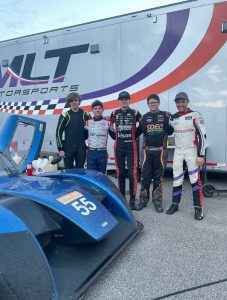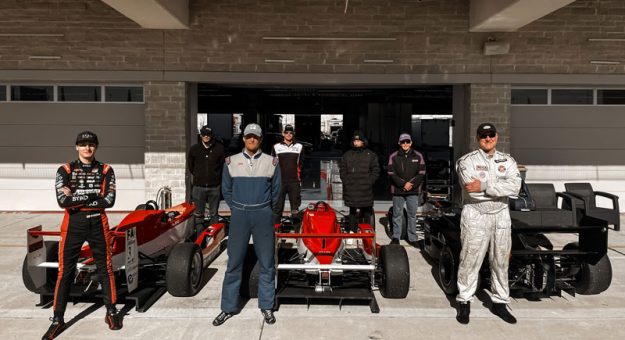MOORESVILLE, N.C. — We covered the start to our season in our previous column, now we move on to what may have been the most successful racing weekend of my career.
That came Feb. 3-6 at Circuit of The Americas, where we participated in the second round of the SCCA SuperTour with the F1000 car in the FA class.
I swept the weekend, winning both poles and both races. I knew going in that as long as no “faster” cars came out to COTA to race, such as the old Swift 016 Atlantic or potentially any F3 cars, that F1000 cars would be considered the next fastest type of car in the FA class.
One of my other goals entering the weekend was to beat the COTA track record for an F1000 car, which was originally Jose Gerardo’s 2.06.69, which was set last year.
It seemed very doable, so I knew all I needed to do was execute.
Enter, “The Executioner.”
On Friday, I qualified pole over Gerardo by almost a full second, with a 2.07.98 lap. That was a good indicator for me about how the rest of the weekend would go.
Saturday’s race was the shorter of the two races, by about 15 minutes. My goal was to stay in front of Gerardo. I wasn’t fully comfortable with the car yet, having not yet found the car’s limits at COTA.
This is big for me, because I don’t have the confidence necessary to go fast enough when I need to, especially at the start of the race. I have to work up to the limit in the opening laps, taking small bites of progression to get there. This opens the door for competitors on the first laps and stretch a lead that could prove to be insurmountable, even if I eventually start running lap times faster than theirs.
Gerardo got me on the start, along with another car that was a slower class car, because of my tentativeness into turn one and through the esses after turn two. After shaking that off, I was able to pass slower cars for second. However, when I tracked down Gerardo, he realized that if I passed him, he would never be able to retake the lead.
That amped up the aggressiveness during our battle through turns 13-15. He ran me off the road twice, once on the inside of 13 and the other into the outside gravel of turn 15.
Exiting the gravel, Gerardo stretched a lead that I almost completely closed again in the next few laps.
However, it was too little too late and I finished second.
I did set the track record on the penultimate lap of the race, turning a 2:05.556 lap.
I told my Arrive Drive Motorsports crew chief and engineer, Dustin Hodges and Jerry Hodges, that I actually won the race and that Gerardo should be issued a penalty for the egregious contact.
Dustin filed a protest and the next morning after testifying about the situation and showing video evidence, we were awarded the victory.
My track record also gave me the pole for the 35-minute second race. Gerardo started second.
I had to develop a killer mindset to start the race in order not to fall behind. This mentality is something I hadn’t really developed up to that point. I was always a build-up-to-speed kind of guy. In this race, I had a very good idea of the limit of the car when the tires aren’t up to temperature.
I was able to hold my lead at the start. A caution came out a few laps into the race and it was a Godsend because I had never raced so hard in a race car from the very start. I was already mentally and physically exhausted.
After keeping my lead on two restarts, I won the race by more than seven seconds.
It was a very satisfying way to top off a weekend of growth, challenges, and success.
Two poles, two wins, and a track record!

From there, we went to NOLA Motorsports Park on Super Bowl weekend for the debut of MLT Motorsports and its NPO1 car. It was a great learning experience.
The NPO1 is a challenge. You have to push the car 100 percent in every corner. The car is lighter, it has significantly more downforce and a lower terminal velocity entering braking zones and as a result you can abuse the brakes.
At NOLA, with its one truly heavy brake zone you would most certainly be going 100 percent every lap, with no regard for the brakes.
When Dakota Dickerson, driving one of the Stratus Racing cars, gained a three-lap advantage by doing a triple stint early in the race, the only way to make up that deficit is to be at 100 percent of your car’s potential throughout the race.
Despite some mechanical issues, we made great strides in the progress of the car. That also helped develop me even more as a driver by helping to understand the importance of developing and fine-tuning a race car.
We had a very good chance of winning both races because of our competitive pace, tire, and fuel strategy – something quite remarkable for MLT Motorsports’ first time out with the car after only having had limited testing opportunities.
Unfortunately, the mechanical issues kept us out of victory lane.
On Friday, we tested, practice and qualified the car. I had four teammates this weekend — Ely Navarro, Matt Christensen, Austin Hill and Josh Sarchet. I had raced against all four drivers at some point in other divisions.
I thought it was pretty cool to now be teaming up with former competitors in what would be for each of us our first race in an NP01 car.
The car felt familiar as I had tested an NP01 car with Stratus Racing at the end of 2021 at Thunderhill Raceway, a difficult and complex track.
On Saturday, after practicing our driver changes, it was time to race. Sarchet started the race and after a solid stint, it was my turn.
The driver swap was a little slow because I needed to adjust my seat belts. I quickly worked up to pace, being sure not to take any big bites in the braking zones.
I began running laps in the optimal pace window while pushing the car little by little in an attempt to find its true limits.
What is unique is a driver has to push the NP01 every lap while navigating 50 different sports cars including a few other prototypes. Each class has different strengths and weaknesses.
Combine that in an actual race makes the NP01 in the WRL one of the best developmental platforms for aspiring and developing formula car drivers.
It was so physically demanding over the course of just one hour that I didn’t think I could go for a second hour. I was fairly relieved when I was informed that I would only be doing the one-hour stint.
I had only one incident on the track which could have proved to be disastrous when I went for a pass on a GTO car that didn’t expect me to make the move. When I dove alongside them, the driver failed to notice me, so I did my best to back out of the corner and avoid contact.
Unfortunately, I still clipped the car with my front left and sent him around. I made an outside maneuver to avoid the car that was in the middle of the track. The car rolled toward the outside of the track, forcing me to take even more extreme evasive action by running off track into the dirt.
I avoided potentially devastating contact by maybe a foot or so.
Fortunately, no damage or penalties came from this racing incident, but I learned my lesson regarding these types of passes.
During my portion of the race, we moved up in position and had made up some time on our competitors. I ran competitive times and had a good average pace throughout the stint.
Unfortunately, despite us being in the running for the overall win and class win, we started experiencing fuel-related mechanical issues, which took us out of contention.
We still finished second in class — a nice accomplishment for MLT’s first race out with the NP01.
With race two on Super Bowl Sunday, we had a different fuel-related issue and had to pull the car from the first half of the race to fix it.
We competed in the second half of the race, getting some solid testing and seat time. I got another solid hour-long stint and that time I felt like I could’ve gone for a double stint, which was a good sign of improvement.
Overall, it was a very positive and developmentally useful first experience in the NP01 with MLT Motorsports.
We finished February at Sebring Int’l Raceway and will pick up the story from there in next week’s column.
